A陈述句改为一般疑问句
- 格式:docx
- 大小:12.64 KB
- 文档页数:2
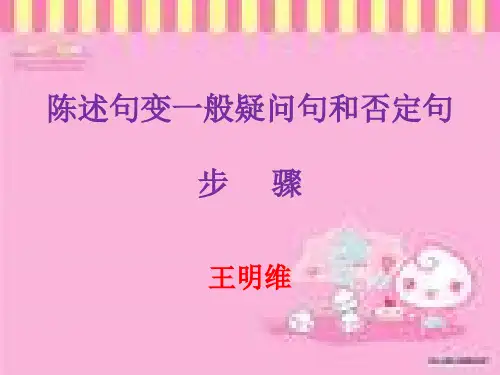
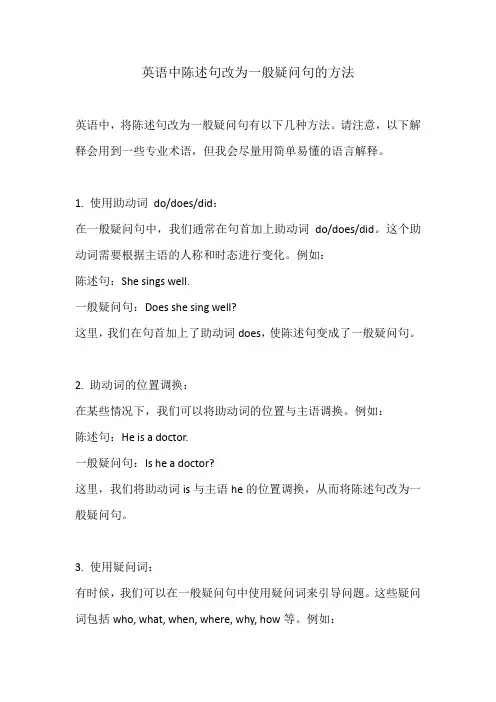
英语中陈述句改为一般疑问句的方法英语中,将陈述句改为一般疑问句有以下几种方法。
请注意,以下解释会用到一些专业术语,但我会尽量用简单易懂的语言解释。
1. 使用助动词do/does/did:在一般疑问句中,我们通常在句首加上助动词do/does/did。
这个助动词需要根据主语的人称和时态进行变化。
例如:陈述句:She sings well.一般疑问句:Does she sing well?这里,我们在句首加上了助动词does,使陈述句变成了一般疑问句。
2. 助动词的位置调换:在某些情况下,我们可以将助动词的位置与主语调换。
例如:陈述句:He is a doctor.一般疑问句:Is he a doctor?这里,我们将助动词is与主语he的位置调换,从而将陈述句改为一般疑问句。
3. 使用疑问词:有时候,我们可以在一般疑问句中使用疑问词来引导问题。
这些疑问词包括who, what, when, where, why, how等。
例如:陈述句:She went to the park.一般疑问句:Where did she go?这里,我们使用了疑问词where来引导问题,从而改变了陈述句的语序。
4. 使用倒装语序:在某些特殊情况下,我们可以使用倒装语序来构成一般疑问句。
具体来说,就是将助动词放在主语之前。
例如:陈述句:You have finished the work.一般疑问句:Have you finished the work?这里,我们将助动词have放在主语you之前,实现了倒装语序。
需要注意的是,这些方法可以单独使用,也可以结合使用,具体取决于句子的结构和语境。
同时,不同的时态和人称也会对这些方法产生影响。
总之,将陈述句改为一般疑问句可以通过加助动词、调换助动词位置、使用疑问词或倒装语序来实现。
这些方法在英语中非常常见,帮助我们构造问句并进行有效的交流。
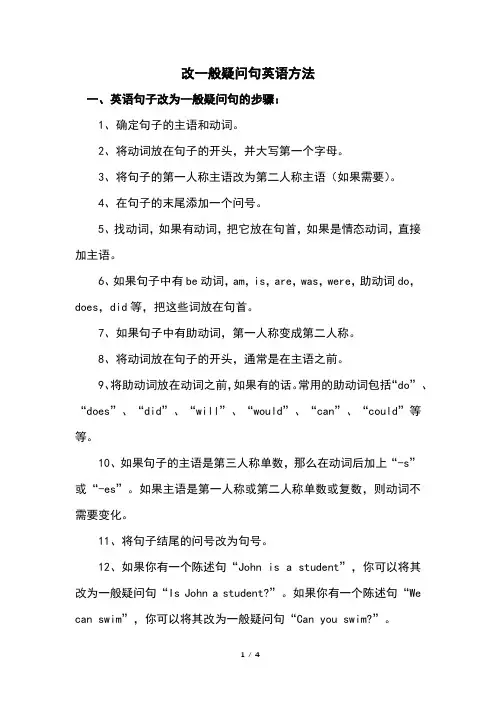
改一般疑问句英语方法一、英语句子改为一般疑问句的步骤:1、确定句子的主语和动词。
2、将动词放在句子的开头,并大写第一个字母。
3、将句子的第一人称主语改为第二人称主语(如果需要)。
4、在句子的末尾添加一个问号。
5、找动词,如果有动词,把它放在句首,如果是情态动词,直接加主语。
6、如果句子中有be动词,am,is,are,was,were,助动词do,does,did等,把这些词放在句首。
7、如果句子中有助动词,第一人称变成第二人称。
8、将动词放在句子的开头,通常是在主语之前。
9、将助动词放在动词之前,如果有的话。
常用的助动词包括“do”、“does”、“did”、“will”、“would”、“can”、“could”等等。
10、如果句子的主语是第三人称单数,那么在动词后加上“-s”或“-es”。
如果主语是第一人称或第二人称单数或复数,则动词不需要变化。
11、将句子结尾的问号改为句号。
12、如果你有一个陈述句“John is a student”,你可以将其改为一般疑问句“Is John a student?”。
如果你有一个陈述句“We can swim”,你可以将其改为一般疑问句“Can you swim?”。
二、英语句子改为一般疑问句的方法:1、观察句子结构:找到句子的主语和谓语,确定是否有be动词或助动词。
2、如果是be动词:将be动词提到句首,将第一人称主语改为第二人称主语(如果有),最后在句末加上问号。
3、如果是助动词:将助动词提到句首,第一人称主语改为第二人称主语(如果有),最后在句末加上问号。
4、如果句子中有情态动词,将情态动词提到句首,第一人称主语改为第二人称主语(如果有),最后在句末加上问号。
5、如果句子中有have或has作为助动词,将have或has提到句首,第一人称主语改为第二人称主语(如果有),最后在句末加上问号。
6、如果句子中有其他特殊情况,根据具体情况进行修改。
三、例句:1、对于句子 "I like ice cream"改为一般疑问句。

陈述句变成一般疑问句:陈述句变为一般疑问句,首先看句中有没有系动词be或情态动词,如果有,把be或情态动词直接提到句首就可以了;如果没有,要用助动词do 或does 来帮助。
基本句式如下:Be + 主语+宾语+ 其他+ ?情态动词+ 主语+ 谓语+ 宾语+ 其他+ ?Do(Does) + 主语+ 谓语+ 宾语+ 其他+ ?(1)如果句子中有be动词(也就是说有is,am,are,were,was等)或是情态动词的(如can, could,will,would等),把be动词或情态动词直接提前,剩下的照抄,然后末尾加上问号。
如:He is a student.(他是一个学生。
)一般疑问句就是:Is he a student?.(他是一个学生吗?)They can play football.(他们会踢足球。
)变成Can they play football?(他们会踢足球吗?)注意:如果主语是I或是we的,一般疑问句一般情况下要把人称改为you。
反之you要改成I,we,me或us。
如:I am a student. 一般疑问句就变成Are you a student?We can help you.(我们能帮你。
)变成Can you help me?(你们能帮我吗?)(2)如果没有be动词和情态动词的,就要用助动词来提问,助动词有do,does,did。
而选择哪个助动词就要由陈述句中的动词时态或形式来决定了。
如:She speaks English very well.(她英语说得很好。
)一般疑问句变成Does she speak English very well?(她英语说得很好吗?)We finished our homework yesterday.(我们昨天完成作业的。
)变为Did you finish your homework yesterday?(你们昨天完成作业的吗?)I go to school on foot.(我走路去上学。
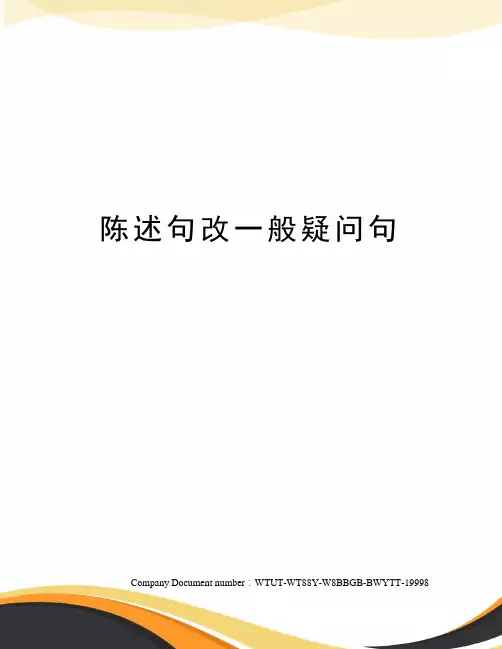
陈述句改一般疑问句Company Document number:WTUT-WT88Y-W8BBGB-BWYTT-199981、陈述句改一般疑问句(1)句子中有be动词(am、is、are、was、were)、情态动词(can、would、may)will时,只要直接把这些词置于句首,句末改成问号;例句:He is a student(他是一个学生)改成一般疑问句就是 Is he a student(他是一个学生吗)(2)如果没有be动词和情态动词,则要用助动词Do或Does、did来帮助例句:she speaks English very well(她英语说得很好)改成一般疑问句Does she speak English very well(她英语说得很好吗)选择好助动词后就可以把原句跟上去,注意的是后面的动词要用原形,如例句中的speak。
2、陈述句改否定句(1)Be动词后加not。
如 is not,are not,am not,was not,were not;(2)在can、should、will后加not。
如can not,should not,will not;(3)上述都没有的,在动词前加助动词否定形式don’t、doesn’t、didn’t;(4)Some改成any例句:she is watching TV now(她现在在看电视)改为 She isn't watching TV nowHe does well in Maths(他的数学很好)改成He doesn't well in Maths(他的数学不好)3、否定句改一般疑问句(1)句子中有be动词的,把be动词提前,其他成分照抄,句末变问号(2)句子中有实义动词的,要使用助动词开头,句中的实义动词变回原形,其他成分照抄,句末变问号(3)句中有情态动词的,把情态动词提前,其他成分照抄,句末变问号例句:He didn’t find his pen under his desk(他没有在他的桌子下面找到他的笔)改成Did he find his pen under his deskWe don’t do eye exercises every day(我们每天不做眼保健操)改成Do you do eye exercises every dayThis problem can not be solved(这个问题不可以解决)改成Can this problem be solved4、一般疑问句用否定句回答含be动词或情态动词的一般疑问句否定回答用:No,主语+be/情态动词+not例句:问句:Are these your English books(这些是你的英语书吗)否定回答:No,they aren’t含行为动词或实义动词的一般疑问句否定回答用“No,主语+do not/does not例句:问句:Do your parents like English(你的父母喜欢英语吗)否定回答:No, they don’t。
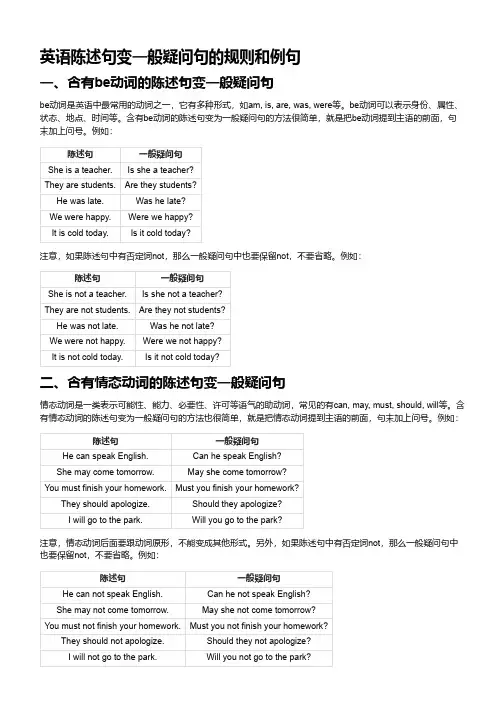
英语陈述句变一般疑问句的规则和例句一、含有be动词的陈述句变一般疑问句be动词是英语中最常用的动词之一,它有多种形式,如am, is, are, was, were等。
be动词可以表示身份、属性、状态、地点、时间等。
含有be动词的陈述句变为一般疑问句的方法很简单,就是把be动词提到主语的前面,句末加上问号。
例如:陈述句一般疑问句She is a teacher.Is she a teacher?They are students.Are they students?He was late.Was he late?We were happy.Were we happy?It is cold today.Is it cold today?注意,如果陈述句中有否定词not,那么一般疑问句中也要保留not,不要省略。
例如:陈述句一般疑问句She is not a teacher.Is she not a teacher?They are not students.Are they not students?He was not late.Was he not late?We were not happy.Were we not happy?It is not cold today.Is it not cold today?二、含有情态动词的陈述句变一般疑问句情态动词是一类表示可能性、能力、必要性、许可等语气的助动词,常见的有can, may, must, should, will等。
含有情态动词的陈述句变为一般疑问句的方法也很简单,就是把情态动词提到主语的前面,句末加上问号。
例如:陈述句一般疑问句He can speak English.Can he speak English?She may come tomorrow.May she come tomorrow?You must finish your homework.Must you finish your homework?They should apologize.Should they apologize?I will go to the park.Will you go to the park?注意,情态动词后面要跟动词原形,不能变成其他形式。
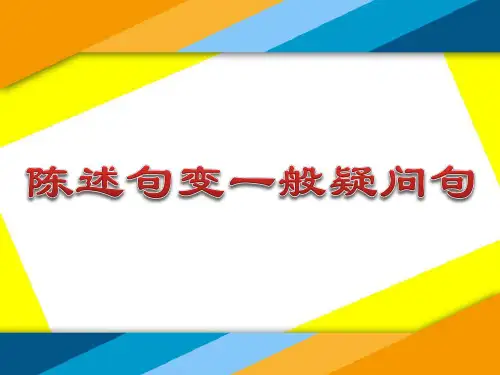
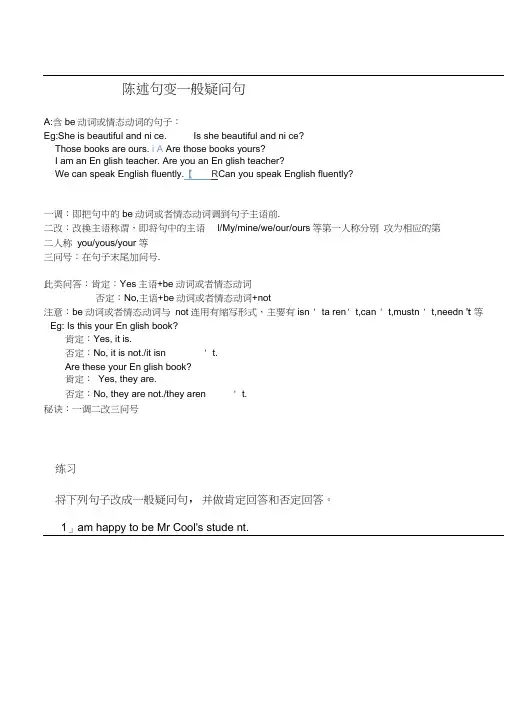
陈述句变一般疑问句A:含be动词或情态动词的句子:Eg:She is beautiful and ni ce. Is she beautiful and ni ce?Those books are ours. i A Are those books yours?I am an En glish teacher. Are you an En glish teacher?We can speak English fluently.【R Can you speak English fluently?一调:即把句中的be动词或者情态动词调到句子主语前.二改:改换主语称谓,即将句中的主语l/My/mine/we/our/ours等第一人称分别攻为相应的第二人称you/yous/your 等三问号:在句子末尾加问号.此类问答:肯定:Yes主语+be动词或者情态动词否定:No,主语+be动词或者情态动词+not注意:be动词或者情态动词与not连用有缩写形式,主要有isn ' ta ren' t,can ' t,mustn ' t,needn 't 等Eg: Is this your En glish book?肯定:Yes, it is.否定:No, it is not./it isn ' t.Are these your En glish book?肯定:Yes, they are.否定:No, they are not./they aren ' t.秘诀:一调二改三问号练习将下列句子改成一般疑问句,并做肯定回答和否定回答。
1」am happy to be Mr Cool's stude nt.2.You are really beautiful.3」can siwm.4.This is an ID card.B:含行为动词或者实意动词的句子一加:即在句首加助动词do或者does (当主语是第三人称单数的时候),注意如果句子是过去时,does/do需变成did二改:一把谓语动词改为原型。
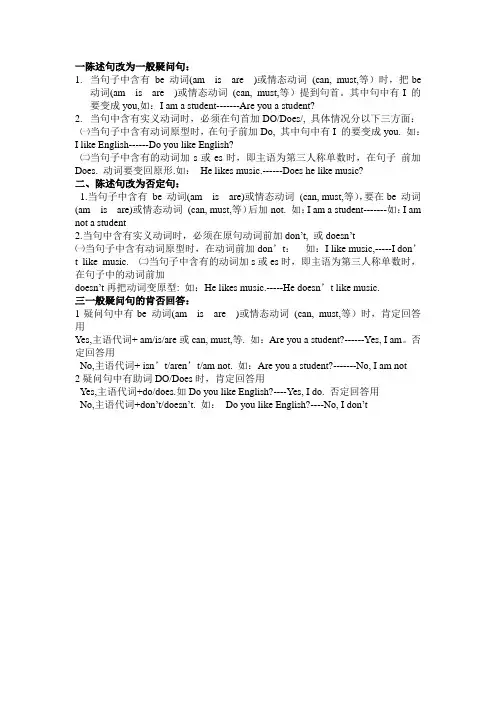
一陈述句改为一般疑问句:1.当句子中含有be 动词(am is are )或情态动词(can, must,等)时,把be动词(am is are )或情态动词(can, must,等)提到句首。
其中句中有I 的要变成you,如:I am a student-------Are you a student?2.当句中含有实义动词时,必须在句首加DO/Does/, 具体情况分以下三方面:㈠当句子中含有动词原型时,在句子前加Do, 其中句中有I 的要变成you. 如:I like English------Do you like English?㈡当句子中含有的动词加s或es时,即主语为第三人称单数时,在句子前加Does. 动词要变回原形.如:He likes music.------Does he like music?二、陈述句改为否定句:1.当句子中含有be 动词(am is are)或情态动词(can, must,等),要在be 动词(am is are)或情态动词(can, must,等)后加not. 如:I am a student-------如:I am not a student2.当句中含有实义动词时,必须在原句动词前加don’t, 或doesn’t㈠当句子中含有动词原型时,在动词前加don’t:如:I like music,-----I don’t like music. ㈡当句子中含有的动词加s或es时,即主语为第三人称单数时,在句子中的动词前加doesn’t再把动词变原型: 如:He likes music.-----He doesn’t like music.三一般疑问句的肯否回答:1疑问句中有be 动词(am is are )或情态动词(can, must,等)时,肯定回答用Yes,主语代词+ am/is/are或can, must,等. 如:Are you a student?------Yes, I am。
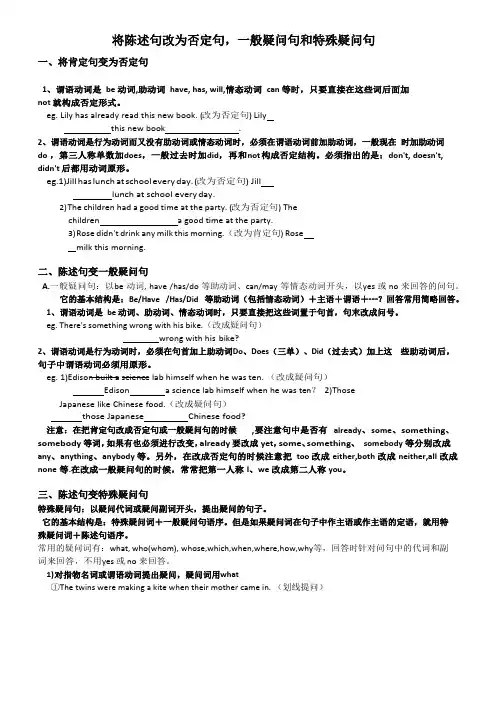
将陈述句改为否定句,一般疑问句和特殊疑问句一、将肯定句变为否定句1、谓语动词是be 动词,助动词have, has, will,情态动词can 等时,只要直接在这些词后面加not 就构成否定形式。
eg. Lily has already read this new book. (改为否定句) Lilythis new book.2、谓语动词是行为动词而又没有助动词或情态动词时,必须在谓语动词前加助动词,一般现在时加助动词do ,第三人称单数加does,一般过去时加did,再和not 构成否定结构。
必须指出的是:don't, doesn't, didn't 后都用动词原形。
eg.1)Jill has lunch at school every day. (改为否定句) Jilllunch at school every day.2)T he children had a good time at the party. (改为否定句) Thechildren a good time at the party.3)R ose didn't drink any milk this morning.(改为肯定句) Rosemilk this morning.二、陈述句变一般疑问句A.一般疑问句:以be 动词, have /has/do 等助动词、can/may 等情态动词开头,以yes 或no 来回答的问句。
它的基本结构是:Be/Have /Has/Did 等助动词(包括情态动词)+主语+谓语+┄?回答常用简略回答。
1、谓语动词是be 动词、助动词、情态动词时,只要直接把这些词置于句首,句末改成问号。
eg. There's something wrong with his bike.(改成疑问句)wrong with his bike?2、谓语动词是行为动词时,必须在句首加上助动词Do、Does(三单)、Did(过去式)加上这些助动词后,句子中谓语动词必须用原形。
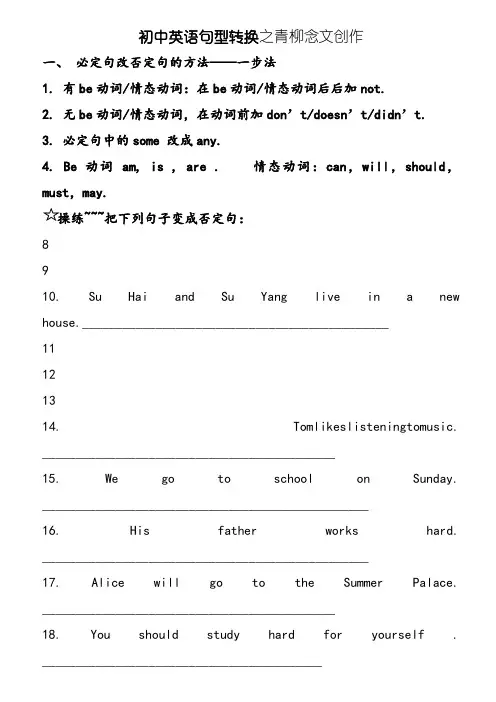
初中英语句型转换之青柳念文创作一、必定句改否定句的方法——一步法1. 有be动词/情态动词:在be动词/情态动词后后加not.2. 无be动词/情态动词,在动词前加don’t/doesn’t/didn’t.3. 必定句中的some 改成any.4. Be动词 am, is , are . 情态动词:can,will,should,must,may.~~~把下列句子变成否定句:8910. Su Hai and Su Yang live in a new house.______________________________________________11121314. Tomlikeslisteningtomusic.____________________________________________15. We go to school on Sunday. _________________________________________________16. His father works hard. _________________________________________________17. Alice will go to the Summer Palace. ____________________________________________18. You should study hard for yourself . __________________________________________1. 有be动词/情态动词:be动词/情态动词提到句首,其余照抄,(some改any,my改your)句末用问号.2. 无be动词/情态动词,在句首加Do/Does/Did,其余照抄,(some改any,my改your)句末用问号.3. 加does、did 的句子注意,句子动词要变成原型.例如:陈述句: They are in the park. He can play the guitar..一般疑问句: Are they in the park? Can he play the guitar?陈述句: I like the ducks. He likes the dogs.一般疑问句:Do you like the ducks? Does he like the dogs?891011121314. Tom likes listening to music._______________________________________关于特殊疑问词问人 (谁) who 地点(何地) where时间(何时) when 、what time 东西/职业/事物(什么) what 方式方法程序身体(怎样)how 原因 why 哪个which 春秋 how old ..怎么样(提建议)How about多少钱 How much谁的whose (book,pen …) 问星期 what day 问日期whatdate问数量多少 (可数名词) How many (people …) 问数量(不成数名词)How much (water …) 颜色 what color班级 what class年级 what grade1、在一般疑问句的基础上,句首添加一个疑问词即可,可根据划线部分确定是什么疑问词.2、接着找be 动词或can ,shall , will 等放在疑问词后面,若没有则请助动词do/does/did 辅佐,写在疑问词后面,how many 除外,必须先写物品,再写be 动词等.3、划线部分去掉后剩下的内容照抄,(some 改成any ,my 改成your 等)4、句点改成问号.1、A: _______ is the boy in blue? B:He’s Mike.2、A: _______pen is it? B:It’s mine.3、A: _______ is the diary? B:It’s under the chair.4、A: _______ is the Christmas Day? B: It’s on the 25th of December.5、A: _______ are the earphones? B:They are 25 Yuan.6、A: _______ is the cup? B:It’s blue.7、A: _______ is it today? B:It’s Sunday.8、A: _______ was it yesterday? B: It was the 13th of October. 9、A: _______ this red one? B:I t’s beautiful. 10.A:_______ is your cousin? B: He’s 15 years old. 11、A:_______ do you have dinner? B: At 6 o’clock.1. The children have a good time in the park.否定句:__________________________________________一般疑问句:________________________________________对划线部分提问:____________________________________2. There are about nine hundred people at the concert.(音乐会)否定句:__________________________________________一般疑问句:________________________________________对划线部分提问:____________________________________3. There is only one problem.否定句:__________________________________________一般疑问句:________________________________________必定/否定回答:____________________________________4. Ann does her homeworkevery evening.否定句:__________________________________________一般疑问句:________________________________________对划线部分提问:____________________________________5. I read an English book every day.否定句:__________________________________________一般疑问句:________________________________________必定/否定回答:____________________________________对划线部分提问:____________________________________6. My brother isin the park now.否定句:__________________________________________一般疑问句:________________________________________必定/否定回答:____________________________________对划线部分提问:____________________________________7. She has some bread for lunch today.否定句:__________________________________________一般疑问句:________________________________________必定/否定回答:____________________________________对划线部分提问:____________________________________8. They read Englishevery day.否定句:__________________________________________一般疑问句:________________________________________必定/否定回答:____________________________________对划线部分提问:____________________________________。
陈述句变一般疑问句解题方法(自创儿歌)鱼的英语备课室2008-11-14 22:18:10 阅读284 评论2 字号:大中小订阅陈述句变一般疑问句解题方法儿歌:陈述变疑问,方法很简单。
有be请提前,没be找“老助”。
(be就是is,am,are,was,were)助动词用哪个,请去原句找动词。
动词原形句首do,动词单三用does.动词过去用did,最后不忘整理原动词。
单三请去词尾s,过去别忘变原形。
1、当句子中有am/are/is/were/was/can/may时变成一般疑问句,直接把这些是动词放到句子开头,结尾加问号?如:It is a beautiful dog(句子中含有am/are/is/were/was/can/may),直接把这些词搬到句子开头就OK啦。
句子变为:=>Is it a beautiful dog ?2、当句子中没有上面这些词,就要学会看动词,根据动词用相应的助动词。
(1)如果动词结尾有s/es,变一般疑问句,句子开头用Does,动词结尾的s/es去掉,结尾加问号?如:He goes to the night school everyday.句子变为:=>Does he go to the night school everyday ?(2)如果动词结尾有d/ed或过去式不规则动词如went,said,felt,saw, got, began,…一般疑问句句子开头用Did,动词结尾的d/ed要去掉(不规则动词要还原如went-go, saw-see,felt-feel,said-say ,got-get, began-begin,…结尾加问号?如:He went to the night school last night.句子变为:Did he go to the night school last night ?(3)如果看不见动词结尾s/es或d/ed就用Do提问,结尾加问号?如:They go to the night school everyday.句子变为:=>Do they go to the night school everyday ?练一练吧!把下列句子改成一般疑问句,并做肯定和否定回答。
i am a student怎么变一般疑问句要将陈述句 "I am a student" 转换为一般疑问句,我们需要遵循一定的语法规则和步骤。
这个过程不仅仅是简单地在句首加上 "do" 或 "does",而是需要考虑句子的时态、主语和谓语动词。
首先,我们要明确原句的时态和主语。
原句 "I am a student" 是一个现在时态的句子,主语是第一人称单数 "I"。
在英语中,现在时态的一般疑问句通常通过将助动词 "do" 或"does" 放在句首来形成,主语则变为第二人称单数 "you"。
接下来,我们需要将谓语动词变为相应的形式。
在现在时态中,当主语是第一人称单数时,谓语动词使用 "am";而当主语变为第二人称单数时,谓语动词应使用 "are"。
因此,我们需要将 "am" 改为 "are"。
此外,为了保持句子的完整性和正确性,我们还需要注意主谓一致的原则。
在一般疑问句中,主语和谓语动词必须保持一致,即主语是第二人称单数时,谓语动词也应使用单数形式。
综上所述,将陈述句 "I am a student" 转换为一般疑问句的过程如下:将主语 "I" 改为第二人称单数 "you"。
将谓语动词 "am" 改为 "are"。
在句首加上助动词 "do",以形成一般疑问句的结构。
因此,陈述句 "I am a student" 转换为一般疑问句后为:"Are you a student?" 这个句子遵循了正确的语法规则,并且清晰地表达了原句的意思,同时也符合一般疑问句的结构和用法。
陈述句变一般疑问句A: 含be动词或情态动词的句子:Is she beautiful and nice?Those books are ours. Are those books yours?I am an English teacher.We can speak English fluently.一调:即把句中的be动词或者情态动词调到句子主语前.二改:改换主语称谓,即将句中的主语I/My/mine/we/our/ours等第一人称分别.改为相应的第二人称you/yous/your等三问号:在句子末尾加问号.此类问答:肯定:Yes,主语+be动词或者情态动词否定:No,主语+be动词或者情态动词+not注意:be动词或者情态动词与not连用有缩写形式,主要有isn’t, aren’t,can’t,mustn’t,needn’t 等Eg: Is this your English book?肯定:Yes, it is.否定:No, it is not./it isn’t.Are these your English book?肯定:Yes, they are.否定:No, they are not./they aren’t.秘诀:一调二改三问号练习将下列句子改成一般疑问句,并做肯定回答和否定回答。
1.I am happy to be Mr Cool`s student.2.You are really beautiful.3.I can siwm.4.This is an ID card.B: 含行为动词或者实意动词的句子一加:即在句首加助动词do或者does(当主语是第三人称单数的时候),注意如果句子是过去时,does/do需变成did二改:一把谓语动词改为原型。
二要改换主语称谓,即将句中的主语I/My/mine/we/our/ours等第一人称分别改为相应的第二人称you/yous/your等三问号:在句子末尾加问号Eg: We read English every morning. Do you read English every morning?Yes, we do./No,we don’t.Tom’s father listens to the radio everyday. Does Tom’s father listen to theradio everyday?Yes,he does./No,he does not.Helen finished her homework yesterday. Did Helen finish her homeworkyesterday?Yes,she did./No, he didn’t.此类问答:肯定:Yes,主语+do/does/did否定:No,主语+do/does/did+not注意,助动词do也常用缩写形式,主要有don’t, doesn’t等秘诀:一加二改三问号C: 加强记忆口诀:“肯变一,并不难,can或be提在前;谓语若为行为动,do或does句首用。
A陈述句改为一般疑问句:姓名:____________
1,There are some special days in April.
2,It’s on April 1st.
3,Monday is his third birthday.
4,Her mother is a Chinese teacher.
5,I will cook noodles for her.
6,Chinese noodles are delicious.
7,We can have a birthday party for both of you.
8,That’s New Year’s Day.
9,My cat has two new kittens.
10,They are very young.
11,The kittens are six days old.
12,They have white fur now.
13,They are cute.
14,Their eyes are open.
15,The boy’s birthday is on July 7th.
16,You will come to the party.
17,I want to practise the song.
18,I need more practice.
19,I’ll go swimming tonight.
20,He’s sleeping.
21,It’s his.
22,The carrots are theirs.
23,The yellow picture is mine.
24,It’s Zhang Peng’s.
25,There is a picture of Shanghai.
26,They are mine.
27,That’s my dog.
28,The book is hers.
29,The dog is yours.
30,I can take him to the park.
31,He is drinking water.
32,Fido is sleeping.
33,These rabbits are eating.
34,I’m looking at a tiger.
35,Here comes a tiger.
36,They like bamboo.
37,The elephant is drinking water.
38,Zhen Ni is reading a book.
39,My name is Lin Xin.
40,They are writing in class.
步骤:1,找Be动词is are am (放第一位)2,其他部分照抄。
(如果没有be动词就找情态动词can will 放第一位,其他部分照抄。
)都没有才找助动词do does will (1be2抄3一二)。